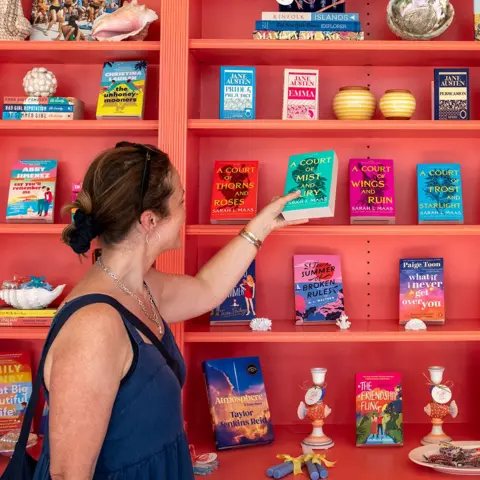In recent years, the perception of romance novels has been evolving, with increasing recognition as a legitimate literary genre rather than merely “smut.” This shift is prominently exemplified in London’s newly established romance-only bookshop, Saucy Books, owned by Sarah Maxwell. Within the shop lies a section dubbed the “smut hut,” a playful nod to the more erotic titles that often define romance fiction. The store caters primarily to a demographic that is enthusiastic about romance novels, predominantly women who, in this era, are not only embracing the genre but also challenging the outdated stigmas associated with it.
Shelves in Saucy Books are stacked with vivid and diverse titles, ranging from Just For the Summer to The Friendship Fling. Young women frequent this shop, engaging in lively discussions and exploring these captivating stories. For Sarah Maxwell, it’s clear that these romance novels embody quality storytelling, characterized by compelling world-building, character development, and intricate plots. In a recent report, UK fiction revenue surpassed a billion pounds for the first time, highlighting the significant role of romance stories in this achievement. Nevertheless, while the popularity of romance is surging, critics often perpetuate a lingering sexist attitude that diminishes the genre’s literary merit.
Romance fiction is incredibly diverse, encompassing various sub-genres that cater to different tastes and moods, yet all share the comforting element of a happy ending—often referred to as a “happily ever after” (HEA). Notably, the rise of “romantasy,” a genre that blends romance and fantasy, has contributed greatly to the mainstream success of romance literature. Its appeal has skyrocketed, especially among TikTok users in the BookTok community, where titles like Fourth Wing and A Court of Thorns and Roses have captivated countless readers with their magical settings and strong female leads.
Readers have shown a keen interest in specific tropes within the genre, such as “enemies to lovers” and “second-chance romance,” which aid in selecting books. Moreover, the “spice level”—a term describing the intensity of sexual content relative to reader preferences—has become a focal point, particularly in fostering a sense of empowerment and pleasure through engaging narratives.
Notably, young romance enthusiasts Sky, aged 23, and Chantelle, aged 24, describe themselves as “proud romance readers,” emphasizing the joy and fulfillment they draw from the genre. They reflect upon their early reading habits, rooted in fanfiction consumed under desks in school, and currently rely on BookTok for recommendations. Despite their enthusiasm, they acknowledge that not everyone is receptive to their love for romance fiction. Responses of disapproval still exist, yet they remain undeterred.
Caroline, another reader recounts her journey back to romance novels after a period of skepticism, noting her rediscovery through Emily Henry’s Book Lovers, a tale of love between a literary agent and a book editor. She expresses regret about missing out on the fun and enjoyment of the genre in her twenties due to misguided notions of superiority regarding literary choices.
Romance novels have gained a robust foothold in the publishing industry, driven not just by consumer trends but also by economic necessity. According to Katie Fraser, a writer for The Bookseller, the genre has historically been marginalized, but as romance readers have emerged as a powerful economic force, publishers are compelled to take notice. Data indicates a remarkable increase in romance and fantasy sales, with the age demographic of women under 35 making up a significant portion of the market.
This shift has also spilled over to literature, with authors such as Bea Fitzgerald, whose young adult fantasy rom-com Girl Goddess Queen aligned perfectly with the growing popularity of romance. She notes that in the past, many potential romantic works might have been categorized into other genres due to perceived audience expectations, but the landscape is changing as readers become unapologetically vocal about their preferences.
Despite the undeniable commercial success of romance, some barriers remain regarding critical appreciation, especially in traditional literary circles. Bea questions the lack of serious literary review coverage for romance novels, hinting that societal biases underline notions of what constitutes “serious” literature. She argues that the happiness often encapsulated in these stories should not detract from their perceived literary merit.
In summary, the landscape of romance fiction is becoming increasingly vibrant and recognized. As attitudes shift and sales soar, the community of romance readers boldly claims its space in the literary world, fueled by a shared passion that reflects broader cultural changes. The period of sneering derision appears to be waning, making way for a revival that celebrates both the joy and complexity inherent in romance narratives. As they embrace the genre unabashedly, romance readers are contributing to a new chapter in the recognition of literature and the importance of diverse narratives.



